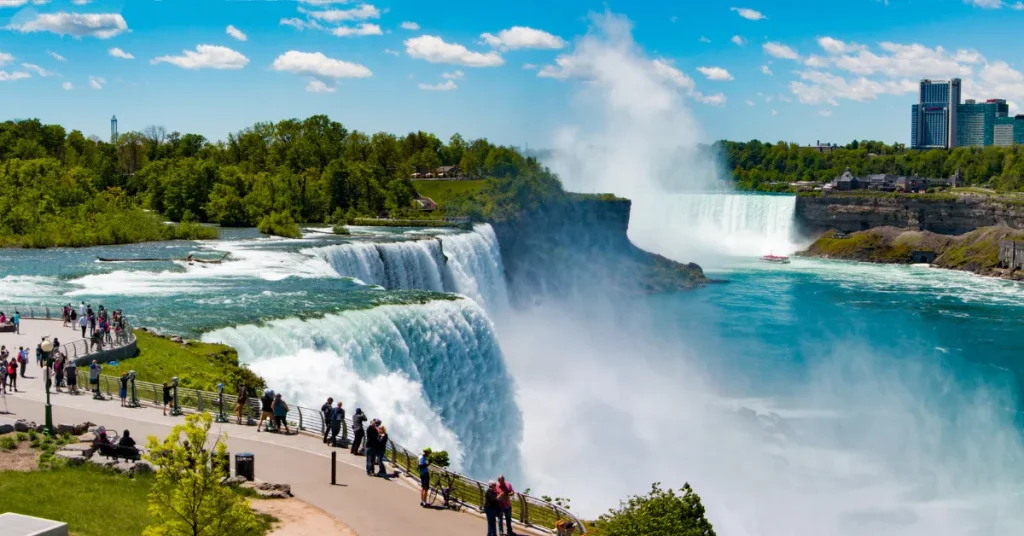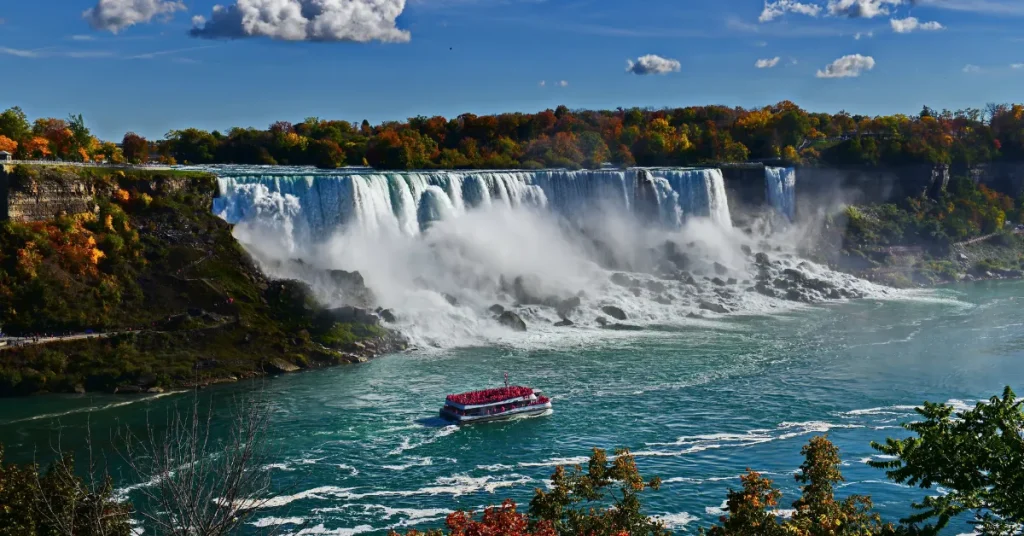Niagara Falls has a maximum depth of 170 feet (52 meters). The Horseshoe Falls on the Canadian side is notably deep.
Niagara Falls, one of the most breathtaking natural wonders of the world, attracts millions of visitors each year.
Straddling the border between the United States and Canada, it comprises three separate waterfalls: the Horseshoe Falls, the American Falls, and the Bridal Veil Falls.
With the Horseshoe Falls being the most expansive and renowned section, it boasts the deepest point at 170 feet. This incredible depth is equivalent to the height of a 17-story building and significantly contributes to the immense power and mesmerizing mist of the falls.
Tourists flock to witness the awe-inspiring sight and the thunderous roar of the waters that serve as a pivotal source of hydroelectric power.
An understanding of the falls’ depth enhances the appreciation of this majestic natural marvel and its substantial impact on the surrounding environment and economy.

Niagara Falls: More Than Meets The Eye
The majestic Niagara Falls captivates millions each year with its awe-inspiring beauty. Yet, there’s a hidden depth to this natural wonder that extends far beyond its visible cascades.
Beneath the shimmering veils of water lies a story of geological might and historical secrets waiting to be uncovered.
The Wonder Of Water And Rock
Niagara Falls forms a natural border between the United States and Canada, with water plummeting over steep cliffs into the churning whirlpool below. The falls consist of three separate waterfalls: Horseshoe Falls, American Falls, and Bridal Veil Falls.
Known for its power, the falls produce over 4 million cubic feet of water every minute during peak daytime tourist hours.
- Horseshoe Falls: The largest and most iconic, with its curved shape.
- American Falls: A high drop-off featuring massive boulders at the base.
- Bridal Veil Falls: The smallest, nestled next to Luna Island.
The depth of Horseshoe Falls reaches approximately 170 feet, while the height of the falls towers at over 180 feet. The dramatic depth is akin to a 14-story building and is a testament to the sheer power of nature’s craftsmanship.
Peeling Back The Surface: What Lies Beneath
Beyond the visible allure of crashing waters, Niagara Falls boasts a cavernous bedrock foundation formed over 12,000 years ago. Submerged in the depths, the rocks tell tales of ancient Earth, with fossils and geological formations hidden beneath the waters.
The relentless force of the water constantly erodes the rock face, reshaping the falls and creating new landscapes.
Researchers and explorers have studied these depths, revealing underwater ledges and hidden depths. The deepest section, at the base of Horseshoe Falls, extends to more than quite a remarkable 35 meters, which effectively makes it deeper than the falls is tall.
This hidden world beneath the falls showcases a dynamic interplay between water and rock, a perpetual dance of construction and deconstruction orchestrated by nature.
Understanding the full depth of Niagara Falls offers a glimpse into a world as fascinating as the thunderous waters themselves.
Measuring The Depths: Methodologies And Challenges
The mystery of Niagara Falls’ depth has intrigued experts and tourists alike. Gazing at the tumbling waters, one wonders about the complex methods used to gauge its depth. This challenge requires a blend of technology and expertise, navigating both the waters and the underlying geology.
Hydrological Surveys: Tools Of The Trade
Hydrological surveys are essential in deciphering the mysteries of Niagara Falls. These surveys employ a variety of tools:
- Echo Sounders: These devices emit sound waves to measure the time it takes for the echo to return.
- Multi-Beam Sonar: This tool provides a detailed map of the riverbed by releasing multiple sound waves at various angles.
- CAD Software: Survey results are digitized to create accurate models of the underwater terrain.
While these instruments are powerful, their effectiveness is often hindered by the powerful currents of Niagara Falls that can disrupt readings.
Geological Complications In Depth Measurement
The geology beneath Niagara Falls adds layers of complexity to depth measurement. Factors include:
- Rocky Terrain: The rough surfaces can cause inaccurate sonar readings.
- Water Clarity: Murky waters can diminish the precision of echo sounders.
- Erosion: Ongoing erosion alters the bottom contours, requiring constant updates to depth charts.
To overcome these challenges, experts often use a combination of tools and repeated surveys to improve accuracy.
Niagara’s Depths: A Comparative Analysis

Welcome to a detailed discussion on Niagara’s Depths. Niagara Falls is a breathtaking natural wonder. It has stirred curiosity about its depth among visitors.
Comparing Niagara To Other Famous Waterfalls
Let’s see how Niagara stands against other giant waterfalls.
| Waterfall Name | Depth (feet) |
| Niagara Falls (Horseshoe) | 170 |
| Victoria Falls | 354 |
| Angel Falls | 3212 |
Niagara is not the deepest, yet its charm is undeniable.
Depth Versus Volume: A Different Perspective
Volume speaks of the water’s power.
- Niagara Falls: 85,000 cubic feet per second
- Victoria Falls: 560,000 cubic feet per second
- Iguazu Falls: 450,000 cubic feet per second
In volume, Niagara shows its might alongside the giants.
Human Interactions With Niagara’s Depths
The depths of Niagara Falls have witnessed numerous human endeavors. For centuries, its mighty waters have drawn people to marvel, and sometimes to challenge its power.
Daredevils And Stunt Performances Over The Falls
Niagara Falls has been a stage for daredevils. Each performance pushes the limits. Thrill-seekers have ventured into the depths in barrels. Others have walked tightropes over the rushing waters.
- Annie Edson Taylor, the first to survive in a barrel.
- Nik Wallenda, tightrope walked across the Falls.
These stunts often bring fame. But they are dangerous. Authorities now forbid such acts without permission.
Harnessing The Depths: Hydroelectric Power
Niagara Falls offers more than beauty and thrills. It is a powerhouse. The waters turn turbines. These turbines create electricity.
| Hydroelectric Station | Capacity | Year Opened |
| Robert Moses Niagara Power Plant | 2,525 megawatts | 1961 |
| Adam Beck Hydroelectric Complex | 1,997 megawatts | 1954 |
This clean energy helps cities and towns. Millions use the power from Niagara. The Falls are a sustainable resource. They show harmony between nature and technology.
The Ecological Impact Of Niagara’s Depth

Think of Niagara Falls, and you might imagine its breathtaking vistas. Niagara’s depth plays a crucial role in sustaining diverse life forms. This unique ecosystem beneath the surface arouses curiosity. Here, we dive into how the depth shapes the ecological character of Niagara Falls.
Depth-influenced Habitats And Biodiversity
Water depth affects sunlight penetration, water pressure, and temperature. These factors create various habitats. Each zone supports distinct species. Together, they make a web of life.
- Shallow Zones: Sunlit, bustling with aquatic plants and small fish.
- Mid-Level Areas: Less light, home to different species like trout.
- Deep Water Regions: Cold, dark, and mysterious with unique organisms.
Remarkably, Niagara’s depth fosters biodiversity hotspots. They serve as nurseries for fish and other wildlife. Some species found here are exclusive to these depths.
Conservation Efforts For Deep Water Ecosystems
Preserving Niagara’s underwater habitats is essential. Conservation groups work hard to protect these ecosystems. Their initiatives ensure lasting biodiversity and health.
- Strict pollution controls safeguard water quality.
- Monitoring programs track habitat changes.
- Education campaigns raise awareness on preservation.
Conservation efforts maintain the balance within Niagara’s waters. They help to keep this natural wonder thriving for generations.
Future Explorations And Technological Advances
The mystifying depths of Niagara Falls captivate explorers and scientists alike. With the help of technology, we are on the brink of new discoveries. Let’s delve into what the future holds for this natural wonder.
Innovations In Underwater Exploration
The world of underwater exploration is advancing rapidly. Cutting-edge robots and submarines now allow us to plunge deeper into the waters of Niagara Falls. These innovations provide a unique glimpse beneath the surface.
- Autonomous Underwater Vehicles (AUVs) navigate the depths, undeterred by strong currents or limited visibility.
- Remote Operated Vehicles (ROVs) transmit real-time data, revealing the underwater secrets of Niagara.
- Advanced Sonar Technology maps the underwater terrain, offering clarity on the ever-changing landscape.
Scientists and engineers continue to develop gear that withstands extreme conditions. Their work promises to unveil the enigma of Niagara’s depths to the world.
Predicting The Impact Of Climate Change On Niagara
Climate change poses a significant threat to natural wonders like Niagara Falls. Experts use sophisticated computer models to understand these risks. This data is critical for preserving Niagara for future generations.
| Climate Model | Purpose | Expected Outcome |
| Hydrological Simulations | Assess water flow changes | Predict variations in waterfall intensity |
| Temperature Projections | Estimate weather patterns | Foresee potential freeze-thaw cycles |
| Erosion Analysis | Evaluate landscape alterations | Anticipate shifts in the waterfall’s edge |
These technological tools help us foresee how Niagara may evolve. Thus, we can design strategies to protect this iconic treasure.
FAQs About How Deep Is Niagara Falls
What Is The Depth Of Niagara Falls?
The deepest part of Niagara Falls is approximately 170 feet (52 meters). This depth is measured from the top of the falls to the bottom of the gorge.
Can You Swim At The Base Of Niagara Falls?
Swimming at the base of Niagara Falls is prohibited due to extremely dangerous currents and the depth. The force of the water is tremendous and hazardous.
How Tall Are Niagara Falls?
Niagara Falls varies in height; the American Falls reach about 70 to 110 feet (21 to 34 meters), while the Canadian Horseshoe Falls drop around 170 feet (52 meters).
What’s Underneath Niagara Falls?
Underneath Niagara Falls, there are rocky surfaces and deep pools. The erosion caused by the falling water constantly changes the bottom landscape.
Conclusion
Diving into the depths of Niagara Falls reveals a stirring blend of natural majesty and raw power.
This iconic landmark, with a depth reaching up to 170 feet in the Whirlpool Rapids, captivates visitors worldwide. Let this be your cue to witness the force of nature up close—Niagara awaits your sense of wonder.
Resources:
1. https://www.nps.gov/places/niagara-falls.htm
